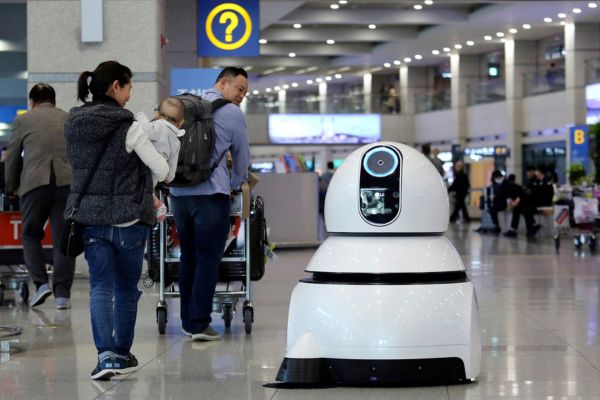According to Precedence Research, the global airport robots market size was valued at USD 1.18 billion in 2024 and is projected to attain around USD 4.29 billion by 2034, at a healthy CAGR of 13.76%.
Airport Robots Market Key Highlights
- North America held the largest share of the global airport robots market in 2024, accounting for 40% of the total market.
- Asia Pacific is expected to emerge as the fastest-growing region throughout the forecast period.
- By type, non-humanoid robots dominated the market with the highest share in 2024.
- By type, humanoid robots are projected to grow rapidly in the coming years.
- By application, the terminal segment secured the largest market share in 2024.
- By application, the landside segment is forecasted to experience notable growth during the forecast period.
- By end-user, the airport security segment led the market with the highest contribution in 2024.
- By end-user, the passenger guidance segment is expected to record the fastest CAGR over the forecast period.
How Is AI Transforming the Airport Robots Market?
AI plays a pivotal role in advancing the airport robots market by enabling smart automation and enhancing passenger services. AI-powered robots assist travelers with real-time flight updates, navigation, and multilingual support, improving overall customer experience. In addition, AI enables facial recognition and behaviour analysis for advanced security monitoring, while robots equipped with AI streamline baggage handling and perform autonomous cleaning and sanitization tasks, especially important in a post-pandemic environment.
Furthermore, AI supports predictive maintenance and operational efficiency by analysing data from airport systems to reduce downtime and optimize resource allocation. These robots also collect valuable insights on passenger behaviour and terminal usage, helping airports enhance service delivery. By personalizing interactions and automating routine tasks, AI is transforming airport operations, making them more efficient, secure, and passenger friendly.
Overview of Airport Robots
Airport robots are increasingly being deployed worldwide to enhance passenger experience, streamline operations, and improve safety and hygiene. These robots perform a variety of tasks, including passenger assistance, security, cleaning, and even entertainment.
Types and Functions of Airport Robots
Passenger Assistance and Wayfinding
Robots like Nao at Tokyo’s Haneda Airport and Josie Pepper at Munich Airport greet passengers, provide directions, answer queries, and offer personalized recommendations. They use AI and can communicate in multiple languages, creating a welcoming atmosphere.
Spencer at Amsterdam Schiphol Airport guides passengers to their boarding gates by scanning boarding passes and adjusting its speed to match the pace of travelers, displaying the distance to the gate on its screen.
Incheon Airport in South Korea uses Airstar, a self-driving, voice-recognition robot that assists passengers with navigation and information.
BLR Airport in India has deployed robots to guide passengers and answer basic queries during trials.
Security and Surveillance
Robots are used for security checks, equipped with cameras, facial recognition, and sensors to detect fake credit cards and currencies. For example, Hamad International Airport in Qatar uses a security scooter robot to monitor pulse rates and detect stress levels in passengers.
Shenzhen Bao’an Airport in China operates Anbot, a robot that can patrol, perform facial recognition, detect fires, and even deploy non-lethal electroshock weapons if needed.
Cleaning and Disinfection
Cleaning robots, such as those used at Heathrow Airport, disinfect surfaces using UV-C light, capable of killing up to 99.9% of pathogens and covering large areas efficiently. These robots support enhanced cleaning programs, especially important post-COVID-19.
Autonomous vacuum robots use LIDAR and SLAM technology to navigate and clean airport surfaces, avoiding obstacles and operating safely in busy environments.
Market Scope
| Report Coverage | Details |
| Market Size by 2024 | USD 1.18 Billion |
| Market Size in 2025 | USD 1.35 Billion |
| Market Size in 2034 | USD 4.29 Billion |
| Market Growth Rate from 2025 to 2034 | CAGR of 13.76% |
| Dominating Region | North America |
| Fastest Growing Region | Asia Pacific |
| Base Year | 2024 |
| Forecast Period | 2025 to 2034 |
| Segments Covered | Type, Application, End-user, and Regions |
| Regions Covered | North America, Europe, Asia-Pacific, Latin America, and Middle East & Africa |
Regional Outlook of the Airport Robots Market
North America
North America dominated the global airport robots market in 2024 and is expected to maintain its lead through 2034. The region’s growth is driven by significant investments in research and development, rapid adoption of robotics for passenger safety, convenience, and enhanced airport experience. The U.S. market is especially strong, with widespread use of autonomous delivery and security robots. North America’s focus on contactless services and advanced security solutions continues to fuel market expansion.
Asia Pacific
Asia Pacific is the fastest-growing region in the airport robots market, with a high CAGR forecasted through 2034. Growth here is propelled by the adoption of robots for cleaning, disinfection, and repetitive operational tasks, particularly in response to heightened sanitation needs post-COVID-19. Airports in countries like China, Japan, and South Korea are embracing digital transformation, integrating robotics for check-in, security, and passenger guidance, which boosts operational efficiency and reduces labor costs.
Europe
Europe holds a significant share of the market, with airports in countries such as Germany, the UK, and the Netherlands leading in the deployment of robots for passenger assistance, security, and cleaning. The region’s focus on smart airport initiatives and sustainability is encouraging further adoption of robotics, particularly as European airports compete to offer seamless and innovative passenger experiences.
Segmental Analysis of the Airport Robots Market
Type Insights
The airport robots market is divided into humanoid and non-humanoid robots. Non-humanoid robots held the largest market share in 2024, as they are highly effective for repetitive and operational tasks such as cleaning, security checks, scanning boarding passes, and passenger transport. These robots significantly enhance productivity and safety while reducing labor costs. However, the humanoid segment is projected to grow rapidly in the coming years, driven by their ability to mimic human interactions and provide personalized assistance, entertainment, and caregiving—especially valuable in regions facing labor shortages.
Application Insights
The terminal segment dominated the market in 2024. Robots are widely used in airport terminals for cleaning, passenger guidance, and operational efficiency, freeing up human staff for more complex tasks. Robots are also being implemented for runway maintenance and construction. The landside segment is expected to witness significant growth, mainly due to the adoption of robots with biometric capabilities for identity verification, parking management, and security outside the terminal.
End-User Insights
The airport security segment contributed the highest market share in 2024. Security robots equipped with high-definition cameras, facial recognition, and AI-driven algorithms are automating screening and maintaining high security standards. The passenger guidance segment is expected to grow at the fastest rate, as robots increasingly assist travelers with navigation, boarding pass scanning, and multilingual support, greatly improving the passenger experience.
Airport Robots Market Companies
- SITA
- ICM
- Vanderlande Industries
- Siemens Logistics
- Pteris Global
- Avidbots
- SoftBank
- Hitachi
- ABB Robotics
- KUKA
Source: https://www.precedenceresearch.com/airport-robots-market

















